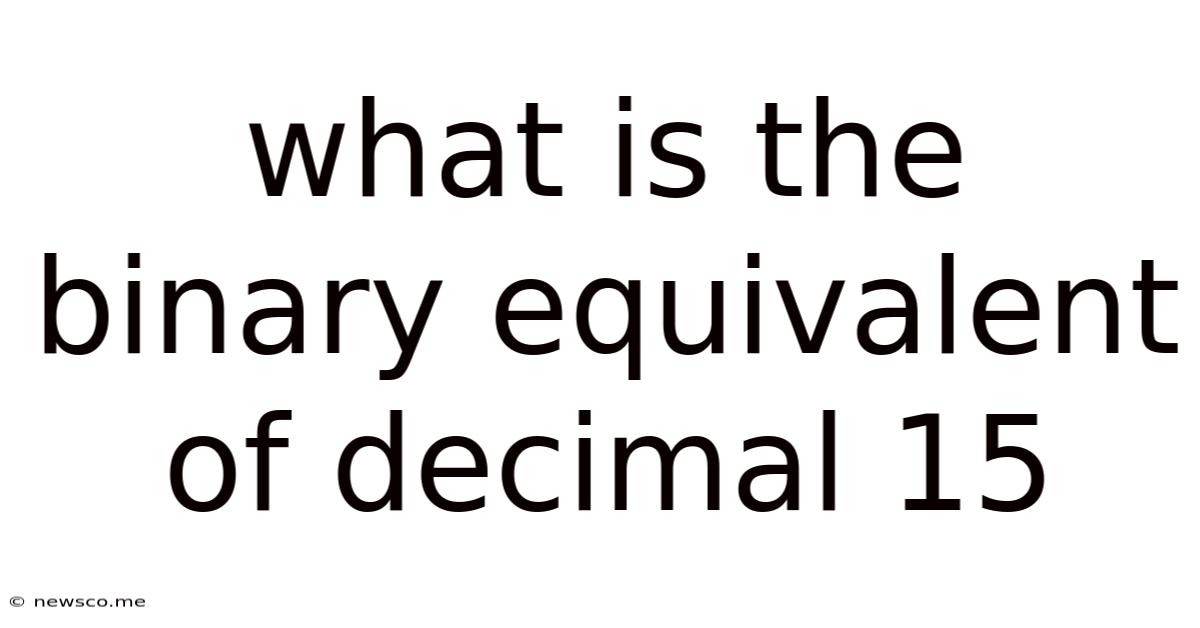What Is The Binary Equivalent Of Decimal 15
News Co
Apr 25, 2025 · 5 min read

Table of Contents
What is the Binary Equivalent of Decimal 15? A Deep Dive into Number Systems
The seemingly simple question, "What is the binary equivalent of decimal 15?" opens a door to a fascinating world of number systems and digital computation. While the answer itself is straightforward (1111), understanding the why behind it reveals fundamental concepts crucial to computer science, programming, and digital electronics. This article will delve deep into this seemingly simple conversion, exploring the underlying principles of binary, decimal, and other number systems, along with practical applications and advanced concepts.
Understanding Number Systems
Before tackling the conversion, let's establish a firm understanding of different number systems. We humans primarily use the decimal (base-10) system, employing ten digits (0-9) to represent numbers. Each position in a decimal number represents a power of 10. For example, the number 1234 is:
(1 x 10³) + (2 x 10²) + (3 x 10¹) + (4 x 10⁰)
Binary, on the other hand, is a base-2 system. It uses only two digits, 0 and 1, and each position represents a power of 2. This system is the foundation of digital computing because it's easily implemented using electronic switches: "on" (1) and "off" (0).
Converting Decimal to Binary: Methods and Techniques
There are several methods to convert a decimal number to its binary equivalent. Let's explore the most common ones, focusing on the conversion of decimal 15:
1. Repeated Division by 2 (The Remainder Method)
This is arguably the most straightforward method. We repeatedly divide the decimal number by 2, recording the remainder at each step. The binary equivalent is formed by reading the remainders in reverse order.
Let's convert 15:
- 15 ÷ 2 = 7 remainder 1
- 7 ÷ 2 = 3 remainder 1
- 3 ÷ 2 = 1 remainder 1
- 1 ÷ 2 = 0 remainder 1
Reading the remainders from bottom to top, we get 1111. Therefore, the binary equivalent of decimal 15 is 1111.
2. Subtraction of Powers of 2
This method involves subtracting the largest possible power of 2 from the decimal number, then repeating the process with the remainder. Let's convert 15 again:
- 15 - 2⁴ (16) is negative, so we start with 2³ (8)
- 15 - 8 = 7
- 7 - 2² (4) = 3
- 3 - 2¹ (2) = 1
- 1 - 2⁰ (1) = 0
Since we subtracted 2³ + 2² + 2¹ + 2⁰, the binary representation is 1111.
3. Positional Value Method (Understanding the Weight of Each Bit)
This method emphasizes understanding the weight of each binary digit (bit). In a four-bit binary number, the positions represent 2³, 2², 2¹, and 2⁰, respectively (from left to right).
To represent 15, we need to find a combination of powers of 2 that add up to 15:
- 2³ = 8
- 2² = 4
- 2¹ = 2
- 2⁰ = 1
8 + 4 + 2 + 1 = 15. Therefore, each position needs a '1', resulting in 1111.
Binary, Decimal, and Other Number Systems: A Comparative Overview
Understanding the relationship between binary and decimal is essential, but it's beneficial to expand our perspective to include other number systems commonly used in computing:
- Octal (Base-8): Uses digits 0-7. Often used as a shorthand for binary because each octal digit corresponds to three binary digits.
- Hexadecimal (Base-16): Uses digits 0-9 and letters A-F (A=10, B=11, C=12, D=13, E=14, F=15). Commonly used in programming and representing memory addresses due to its compact representation of binary data. Each hexadecimal digit represents four binary digits.
Practical Applications of Binary and Decimal Conversions
The ability to convert between decimal and binary is fundamental in various areas:
- Computer programming: Understanding how numbers are represented in binary is crucial for low-level programming, bit manipulation, and working with hardware.
- Digital electronics: Binary is the language of digital circuits and logic gates. Conversions are necessary to design and understand digital systems.
- Data representation: Files, images, and other digital data are stored and processed using binary representations.
- Networking: IP addresses and network protocols utilize binary representations.
Advanced Concepts: Beyond the Basics
Let's explore some more advanced concepts related to binary representation:
- Signed Integers: Representing negative numbers in binary requires techniques like two's complement, which is widely used in computers.
- Floating-Point Numbers: Representing real numbers (numbers with fractional parts) involves a more complex binary representation using mantissa and exponent.
- Bitwise Operations: Manipulating individual bits within a binary number using operations like AND, OR, XOR, and NOT is essential in many programming tasks.
- Data Structures: Understanding binary representation is critical for understanding how data structures like binary trees and binary search trees are implemented.
Conclusion: The Significance of Binary and Decimal Conversion
The conversion from decimal 15 to its binary equivalent, 1111, may seem simple at first glance. However, a deeper exploration reveals the foundational principles of number systems and their crucial role in the digital world. Mastery of these conversion methods, along with a broad understanding of binary, decimal, and other number systems, is essential for anyone pursuing a career in computer science, programming, or related fields. This knowledge opens the door to a deeper appreciation of how computers work and the underlying logic that powers modern technology. Beyond the basic conversion, exploring advanced topics like signed integers, floating-point numbers, and bitwise operations will further enhance your understanding and capabilities in this critical area of computing.
Latest Posts
Related Post
Thank you for visiting our website which covers about What Is The Binary Equivalent Of Decimal 15 . We hope the information provided has been useful to you. Feel free to contact us if you have any questions or need further assistance. See you next time and don't miss to bookmark.